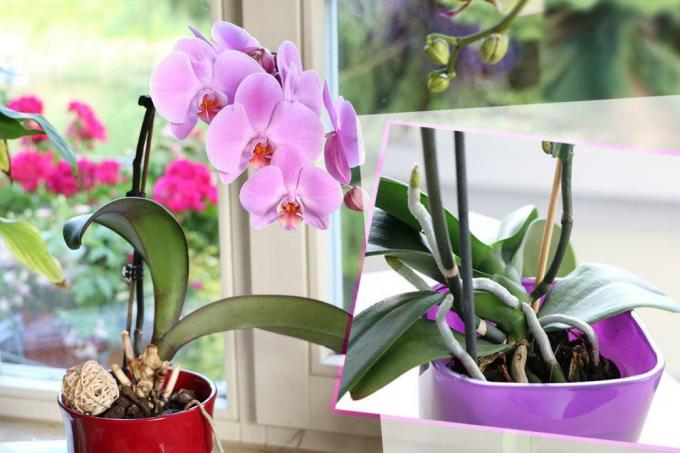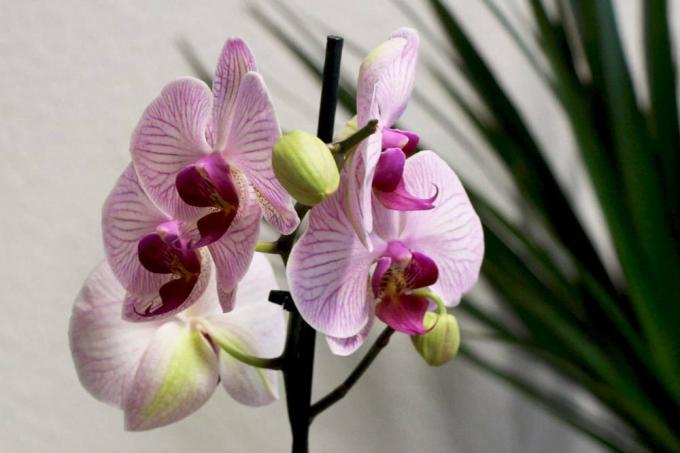
table of contents
- The orchid has soft, slack leaves
- Causes and Actions
- Care errors
- Lack of water
- Waterlogging
- Excess lime
- Location error
- Pests
Orchids need solid, green foliage to survive. If it changes, the plants need help because something is wrong and there is an urgent need for action. For example, if your orchid has soft or slack leaves. It is best to start investigating the cause immediately and take the appropriate countermeasures so that the orchid can survive.
The orchid has soft, slack leaves
If some of the leaves on an orchid become limp, soft, or yellow, then you don't need to worry seriously because then it is likely a natural phenomenon. However, if limp leaves get out of hand then you should investigate the reasons and act quickly to save the plant. Because in this case it is very likely that the orchid has been cared for incorrectly.
Causes and Actions
There are many unnatural causes of soft and sagging leaves on the orchid. Usually, however, they can be traced back to one of the following reasons:
- Care errors
- Location
- Pests
In principle, a combination of the causes is also possible. If this is the case, then all causes must be eliminated in order for the plant to survive. It is important that you do not cut the leaves, even if they are unsightly, because the interfaces are gateways for pests that harm the weakened plant even more.
Care errors
Orchids are considered demanding plants. The most common care mistake occurs when watering, because both too much and too little water cause the leaves of the orchid to become limp.
Lack of water
If orchids don't get enough water, they suffer. You can show this with the following features:
- soft foliage
- sloping buds
- withered flowers
If the plants show this picture, you should not hesitate long and act immediately. The simplest and most proven method in the event of a lack of water is a so-called. Immersion bath. To prepare for the immersion bath, proceed as follows:
- Fill the vessel with lime-free, lukewarm water
- Size of the container: the orchid's pot must fit well
If everything is ready, you can use the Immersion bath kick off:
- Place the orchid and the pot in the prepared immersion bath
- Foliage must not get wet
- wait a few minutes (until no more bubbles rise)
- Take the plant out of the immersion bath
- place on a coaster
- wait a few minutes
- Remove the water from the coaster
- Plant if necessary put back in the pot
Although the immersion bath helps the orchid in the struggle for survival, it cannot work miracles either. This is why you should give the orchid some time so that it can recover. The plant shows you whether the rescue attempt was successful by sprouting new and healthy shoots. To support them, it is advisable to immerse the plant once a week.
tip: So that your orchids do not suffer from a lack of water in the future, you should also use them for the normal water supply diving instead of pouring. That is better for the plants.
Waterlogging
If the orchid receives too much water, even if it is well-intentioned, then its feet are constantly "wet", i.e. the roots are permanently under water. Over time, this causes the roots to begin to rot (Root rot) and the water supply to the orchid is disturbed. Signs of the onset of root rot on the orchid are soft, limp and withered leaves. As with a lack of water, you should immediately take remedial measures in case of waterlogging:
- Lift the orchid out of the pot
- Carefully shake off the substrate
- mushy and brown Cut off the roots with a sharp and clean knife
- remove all flower stems
- Plant needs strength to develop roots
- Carefully rinse the root ball under running water
- Let the orchid dry well
- plant in new, dry substrate
- do not water and do not fertilize for the time being
The orchid needs water so that too much water does not turn into a lack of water. Therefore it is best for the plant in the following days or weeks if you spray it with lime-free, lukewarm water. If the plant is well rooted again, then watering or can be dived, but in any case more economical than before.

tip: A typical characteristic of waterlogging is when there is a Coaster water accumulates. So that your orchids do not get too much water in the future, reduce watering or switch to the immersion bath for water supply.
Excess lime
If casting errors can be excluded as the cause, then you should consider the water quality, because the plants do not tolerate lime. And the German tap water is unfortunately very calcareous in many places. Watering with tap water can mean that the roots can no longer absorb nutrients. This can be seen in the soft and limp leaves of the orchid. The solution to the problem is to reduce lime scale. There are the following options:
- Use rainwater for watering
- Filter tap water before watering
- Boil tap water
Location error
If the orchid is in the blazing sun, the leaves become soft and limp, as the tropical plant cannot tolerate too much sun. In this case she needs a new location that
- bright to partially shaded and
- warm (with a temperature of 20 ° C to 25 ° C)
is. Ideally, the location also has a humidity of 50 to 80 percent.
Temperature fluctuations
An orchid doesn't like temperature fluctuations at all. For example, if she is in a room in winter that is not regularly or When heated evenly, its leaves will become limp and sloppy. The proximity to a fireplace, which develops a lot of heat during the day and cools down at night, also causes problems for the plants.
The solution to the problem is very simple here. Because you only have to relocate the plant to a location with uniform temperatures and without direct sunlight. Ideally, the new location is on a north, east or west window.
Pests
While mistakes in care and location are ultimately homemade, pest infestation is difficult to prevent. Soft and limp leaves of the orchid can therefore also arise from pests, especially from pests that feed on the sap. This includes all plant lice, but above all sign-, lubricating and Mealybug.
Since lice spread very quickly, there is a need for immediate action. Proven measures against the plague are:
- Cloth with alcohol to wipe the leaves
- Dab the plant with a cotton swab soaked in alcohol
- Pack the orchid airtight for two to three days (oxygen supply is interrupted)
- Spraying the plant with a soft soap solution



